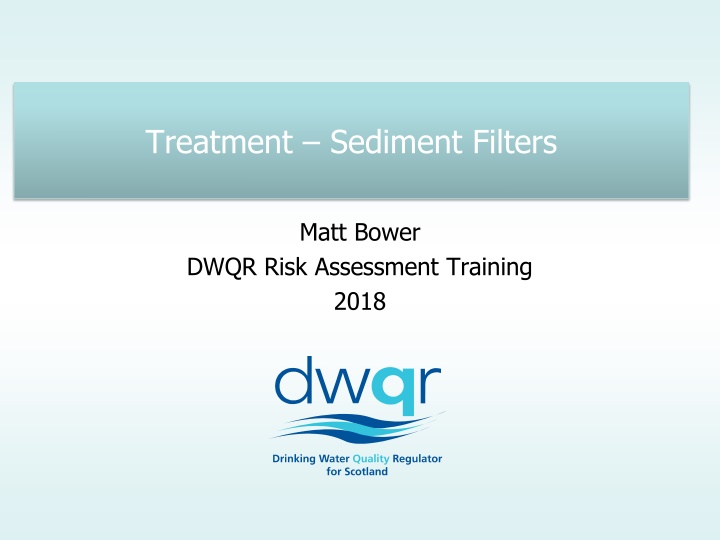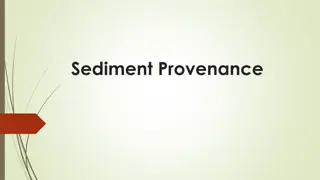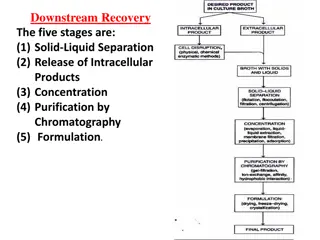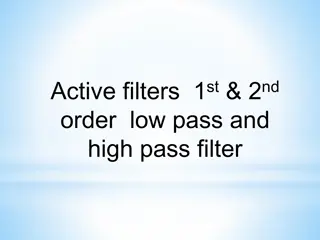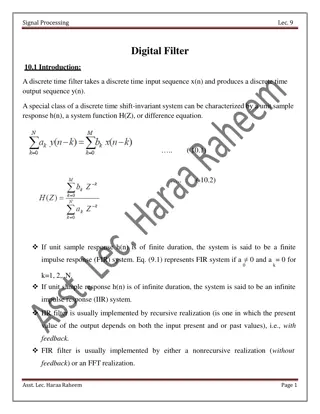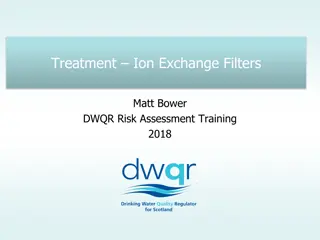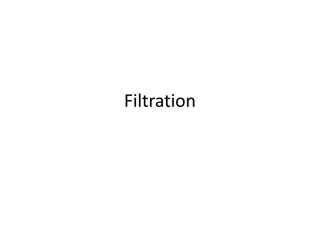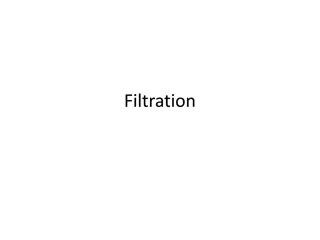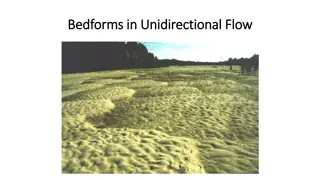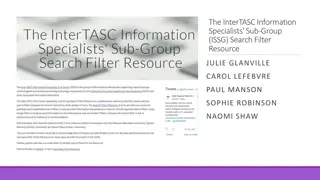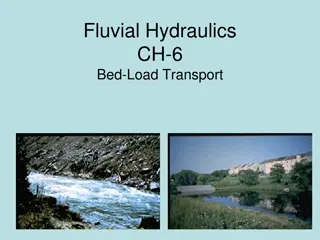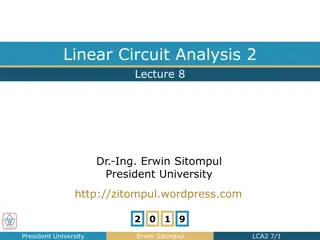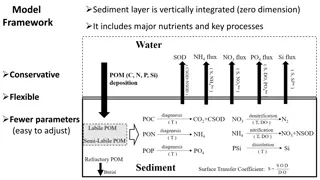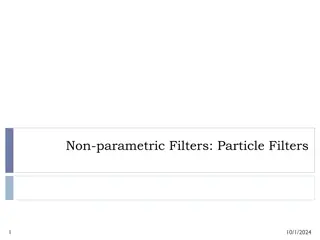Overview of Treatment Sediment Filters for Water Systems
Treatment sediment filters are commonly used for metal removal in larger water systems. These filters contain loose media and require backwashing to maintain efficiency. Understanding their usage and maintenance is crucial for effective water treatment.
Download Presentation

Please find below an Image/Link to download the presentation.
The content on the website is provided AS IS for your information and personal use only. It may not be sold, licensed, or shared on other websites without obtaining consent from the author.If you encounter any issues during the download, it is possible that the publisher has removed the file from their server.
You are allowed to download the files provided on this website for personal or commercial use, subject to the condition that they are used lawfully. All files are the property of their respective owners.
The content on the website is provided AS IS for your information and personal use only. It may not be sold, licensed, or shared on other websites without obtaining consent from the author.
E N D
Presentation Transcript
Treatment Sediment Filters Matt Bower DWQR Risk Assessment Training 2018
Overview Filters containing loose media, housed in a plastic or metal shell Usually (but not always) for larger PWS Point of Entry or Common treatment systems Often contain sand, but may contain other inert or catalytic media May be used to removal metals (perhaps with oxidation stage)
Usage Sealed Units operate under pressure May be installed in series or parallel Usually downflow; need backwashing to avoid bed compaction and clogging Sometimes have automatic backwash timer fitted on top Should be sited where there is room to access for inspection and maintenance
Usage Metals removal Iron, Manganese, Chromium (III), Selenium, Arsenic (III) Usually need to oxidise metal to make it insoluble Aeration is easiest air sparge pipe; cascade Some metals (Mn) may require chemical oxidation (Cl) or raising pH Thought on design needed (want metal to precipitate on filter!) May be desirable to have detention (settlement tank) upstream to allow precipitation
Usage Backwashing Needed to expand bed and wash off deposits Can use mixture of air and / or water Flow and frequency needs to be set to according to usage (watch until B/W water runs clear) Ideally use automatic timed system Backwashing problems Lack of sufficient clean water Starving system of water during B/W Disposal of B/W water Insufficient flow / time / frequency
Key Points to Watch For Are we clear what filter is there to do (solids, metals, chemicals)? Is it sufficiently sized? Is there any media inside it?! Is any pre-oxidation sufficient? What is the backwash regime? Is it enough? Is it monitored? Maintenance (media, moving parts)
Questions Filtration may be preceded by pre-oxidation dependent on the solubility of the metals in the source water and corresponding design of the treatment works. Pre-oxidation brings the metals out of solution so that they can be removed through the filter from the raw water. Evidence of the requirement for pre- treatment or of inadequate pre-treatment is raised levels of metals in the filtered water. Filter performance may be determined using turbidity monitors - ideally on the outlet of each filter. Where filtered water turbidity is higher than 1.0NTU or where this value is frequently approached then action is needed to improve filter performance and/or any preceding treatment processes. A typical filter cycle will show increased turbidity at the start and end of the cycle (after commissioning and prior to backwashing or refurbishment); these are normal and should be managed operationally. Where there are no turbidity monitors or metal levels are not routinely checked then process issues with filters may go undetected. Confirm whether the operator checks the filters, e.g. the surface should appear an even colour, they should be monitored for headloss and turbidity. Determine the regularity of these checks, and of backwashes and media replacement. Check that the filters are managed so they cannot overload; the number of filters should be appropriate to the volume of water being processed. The operator should ensure that the incoming water is evenly distributed across all filters. Although fairly trouble-free, all filters need maintenance to ensure that they continue to operate effectively. Any automatic backwash mechanisms should be checked and serviced in accordance with manufacturer's guidelines. Valves should be checked to ensure they remain operable. The media in the filter should be inspected periodically to check that it is in good condition and there is sufficient to enable the filter to perform effectively. Could soluble metals be present due to inadequate pre-oxidation (if process requires it - Fe / Mn)? Management and ResilienceTreatment TSF1 5 Could process issues across filters go undetected? (e.g. are there turbidity or head loss monitors?) Installation and Operation Treatment TSF2 5 Management and ResilienceTreatment Do the filters block/overload? TSF3 5 Management and ResilienceTreatment Is there a risk of poor or no maintenance? TSF4 4 is there a risk that instructions for the filter operation and maintenance are undocumented? All filters should be operated in accordance with manufacturers' instructions. If these are not present, there is a risk that the performance of the filter could be compromised due to inappropriate operation or inadequate maintenance. Management and ResilienceTreatment TSF5 5
Questions Most filters are designed to be backwashed periodically to clean the media and remove dirt and sediment that has accumulated on the surface of the bed. Poor washing can greatly reduce the effectiveness of filtration. Sometimes the design of the filter can be the cause of inadequate backwashing, in other cases it is due to deficiencies with the operation and maintenance of the filter. An effective backwash should expand the media bed and have sufficient vigour to lift particulate matter and remove it via the waste stream. The timings for the wash should be set so that the washwater is running clear by the time the backwash ends. Installation and Operation Is there evidence that backwashing is inadequate? Treatment TSF6 5 Dirty backwash water can contain harmful pathogens. During the period when a filter is returned to service immediately after a backwash there is an increased risk that dirty water will enter the supply. A "run to waste" or "slow start" mechanism can reduce this risk. With the design of some filters, dirty washwater that remains in pipework after the wash can enter supply once normal flow is re-started. Could dirty water left in the filter or pipework enter the supply when filters first start up (e.g. does it run to waste?) Installation and Operation Treatment TSF7 5 Could inadequate / loss of media cause quality problems? Any filter needs sufficient media in order to perform effectively. The media in the filter should be inspected periodically to check the amount of media. Media should be topped up if necessary. Management and Resilience Treatment TSF8 4 Could backwash water be inappropriately disposed of and become a risk to quality? Dirty Backwash water can contain harmful pathogens. It should be disposed of in a manner that prevents it re-entering the treated water stream or causing contamination elsewhere. Management and Resilience Treatment TSF9 5
